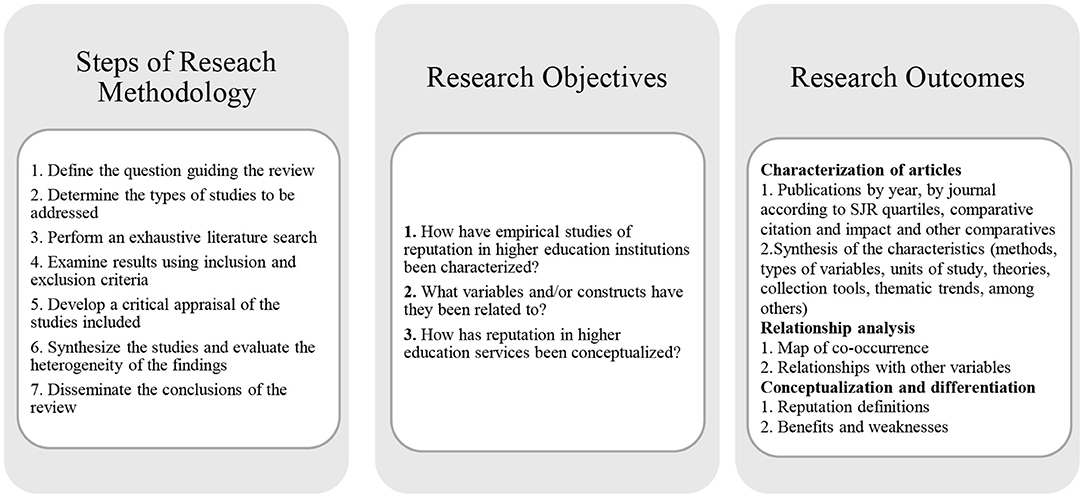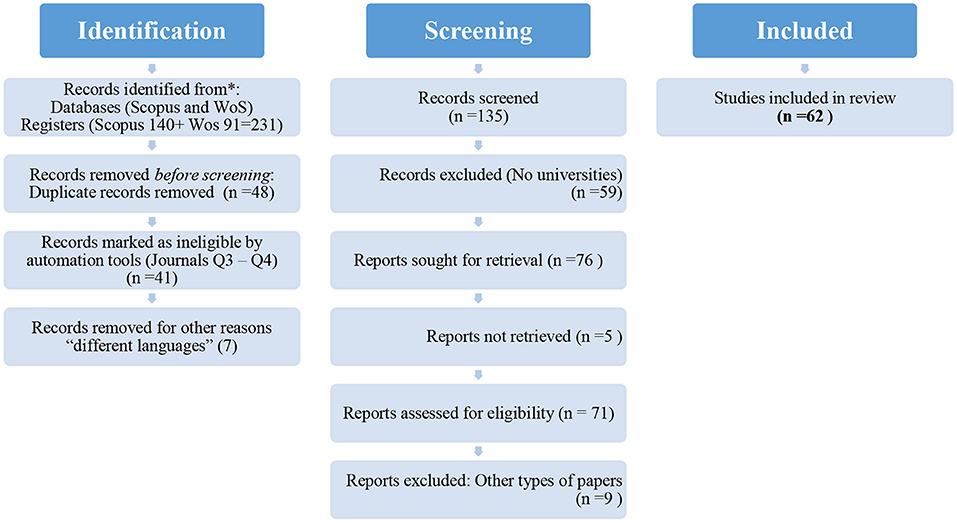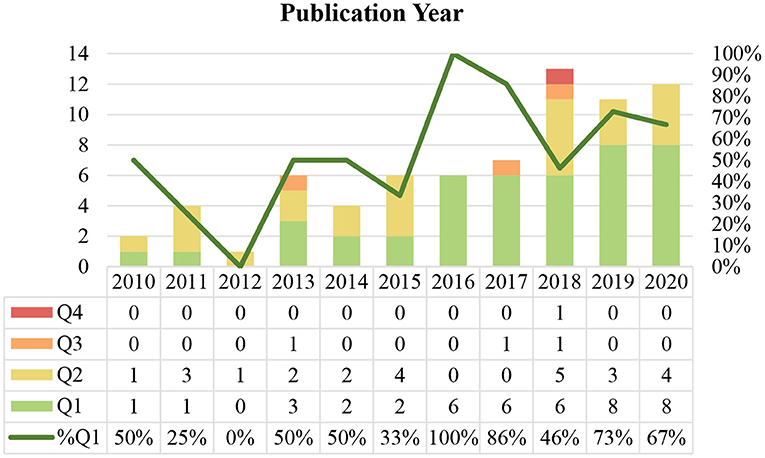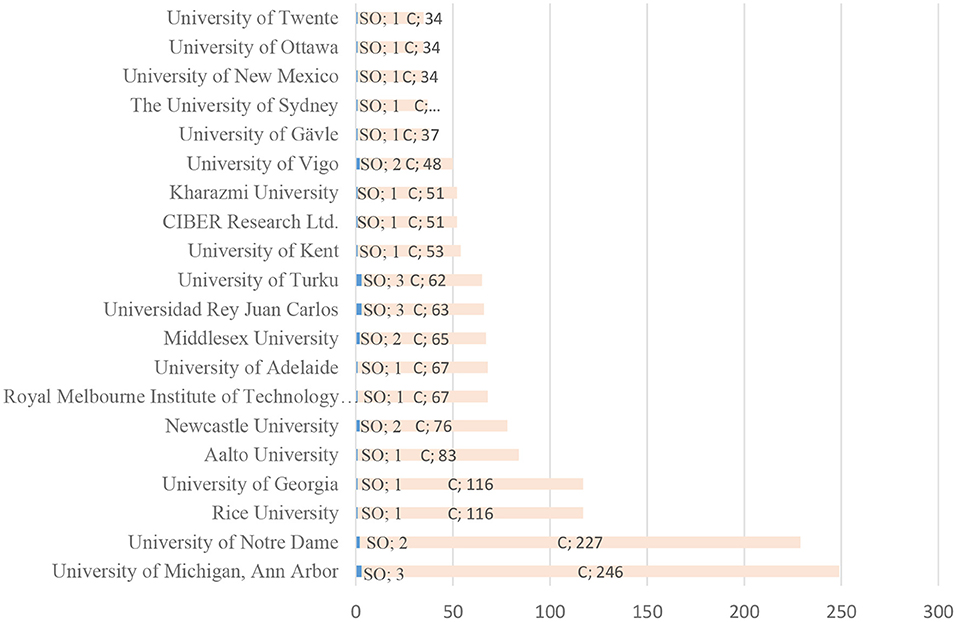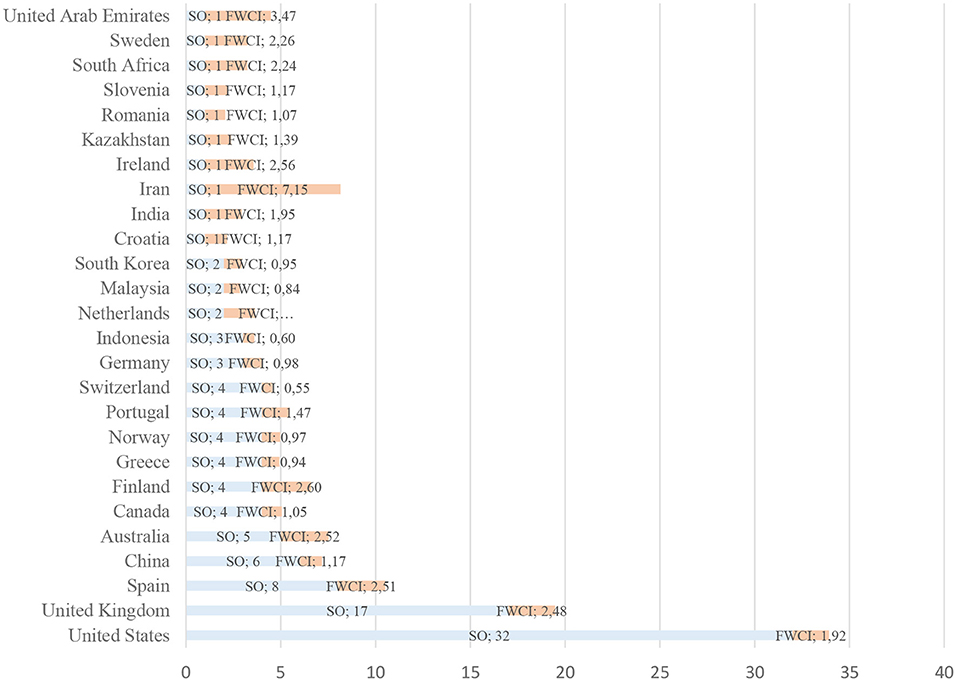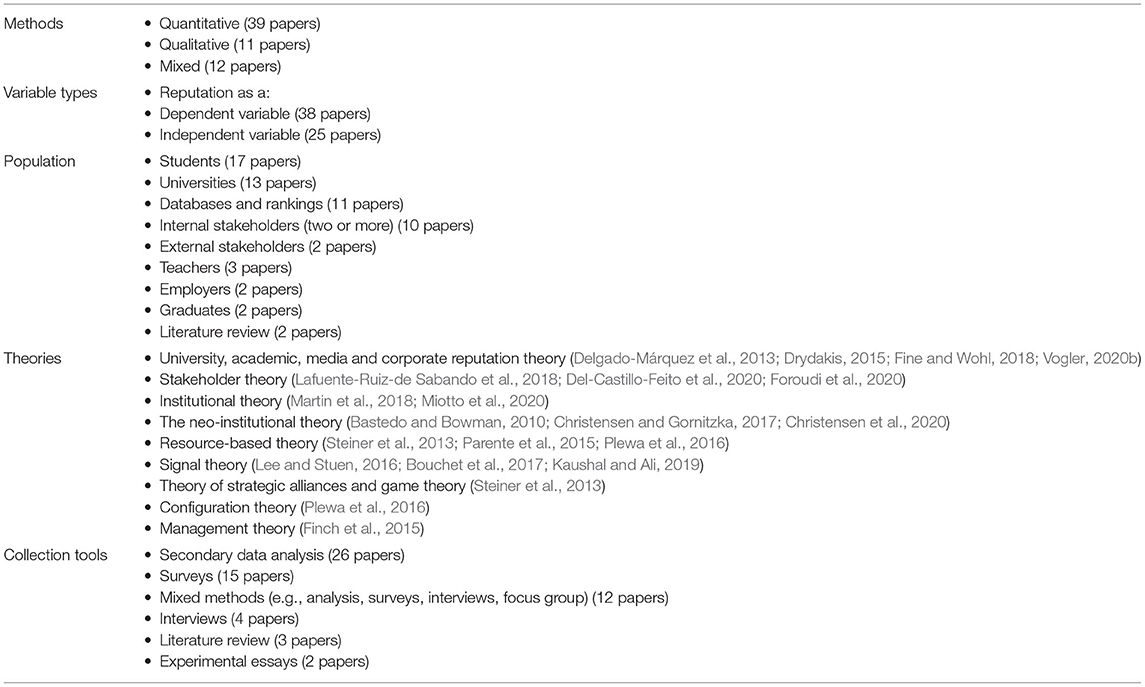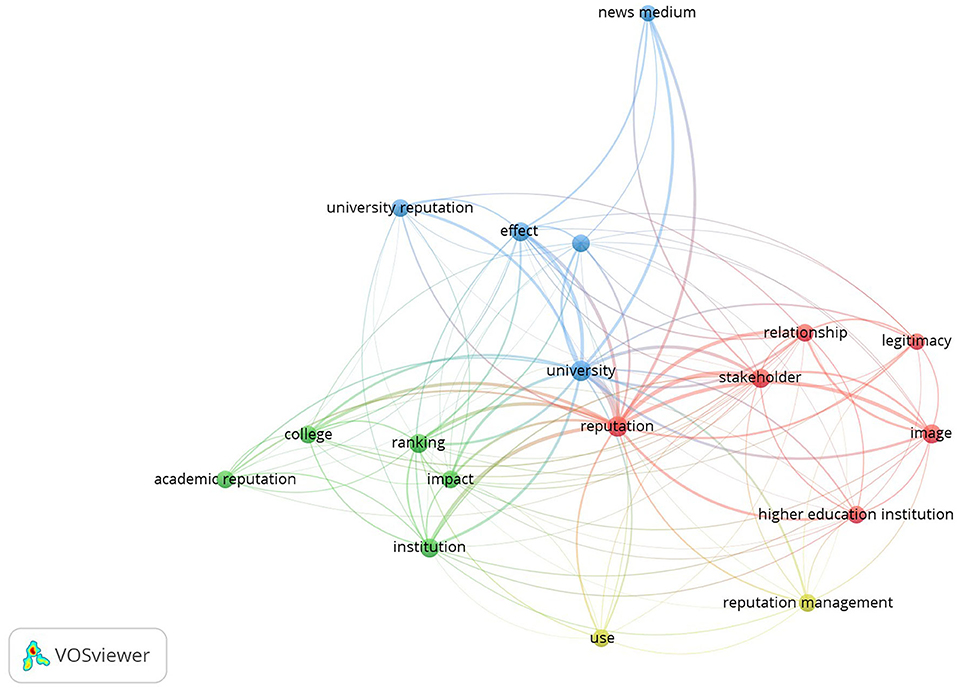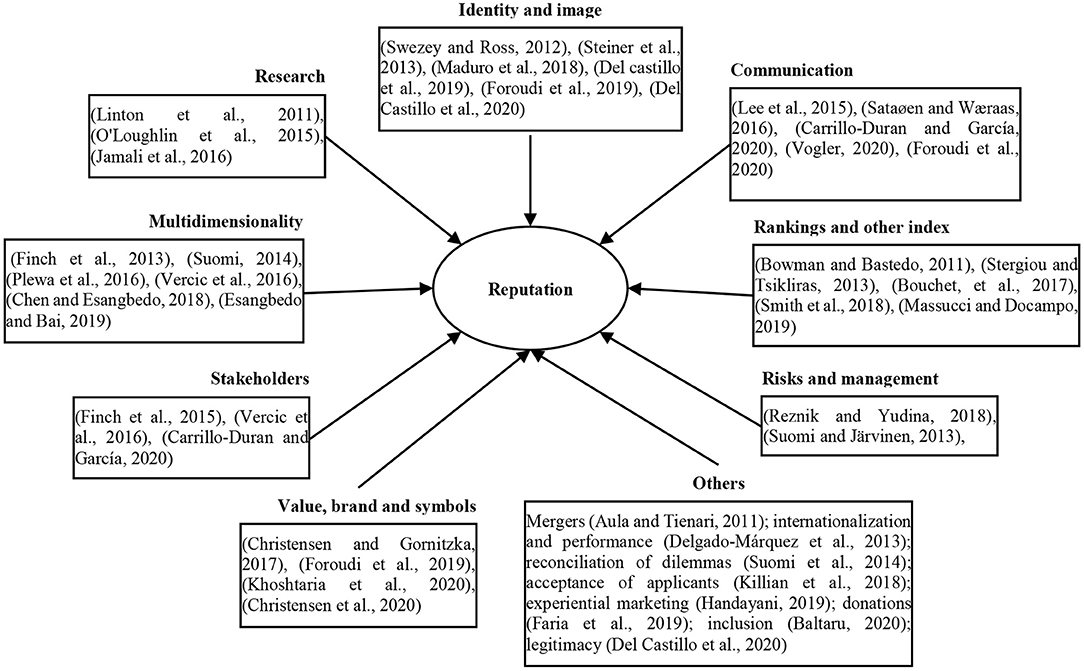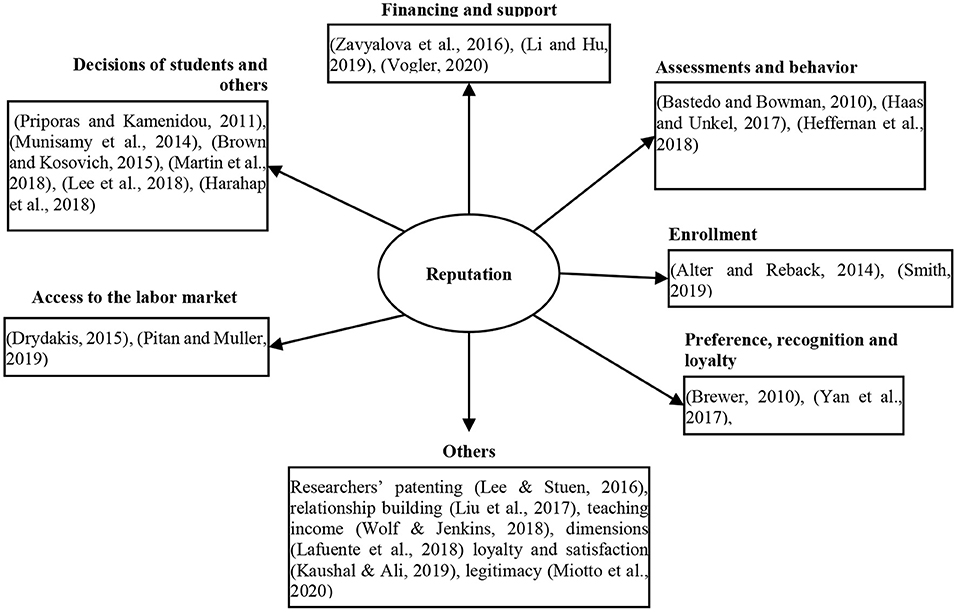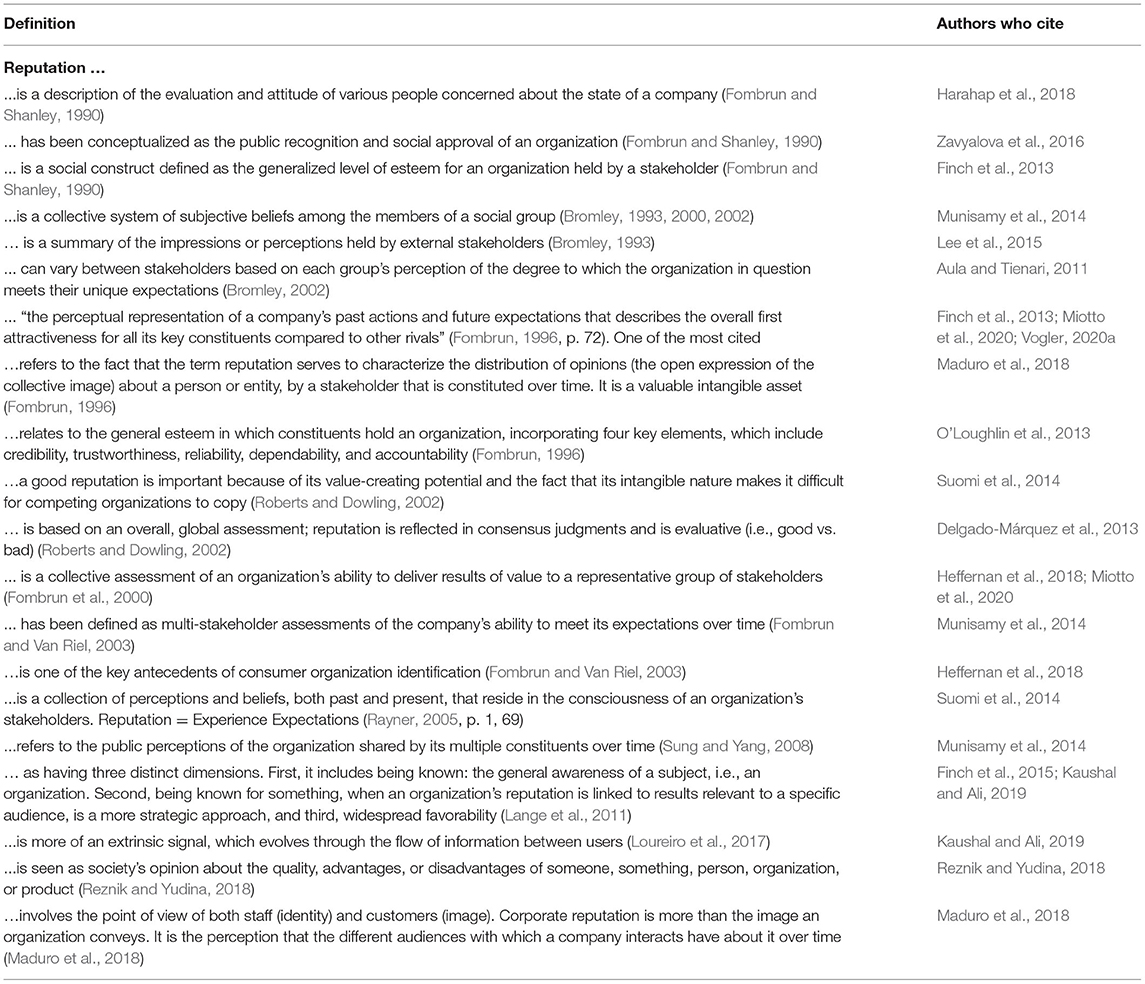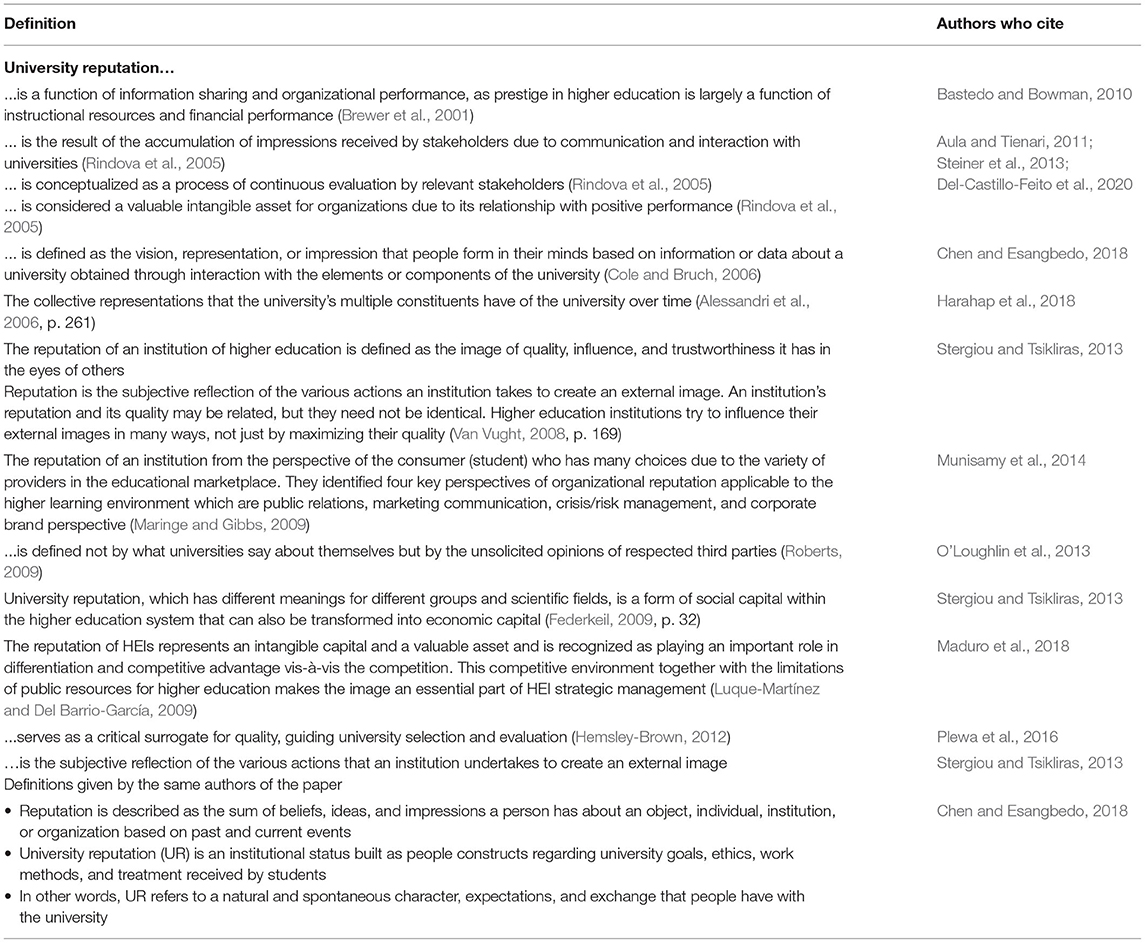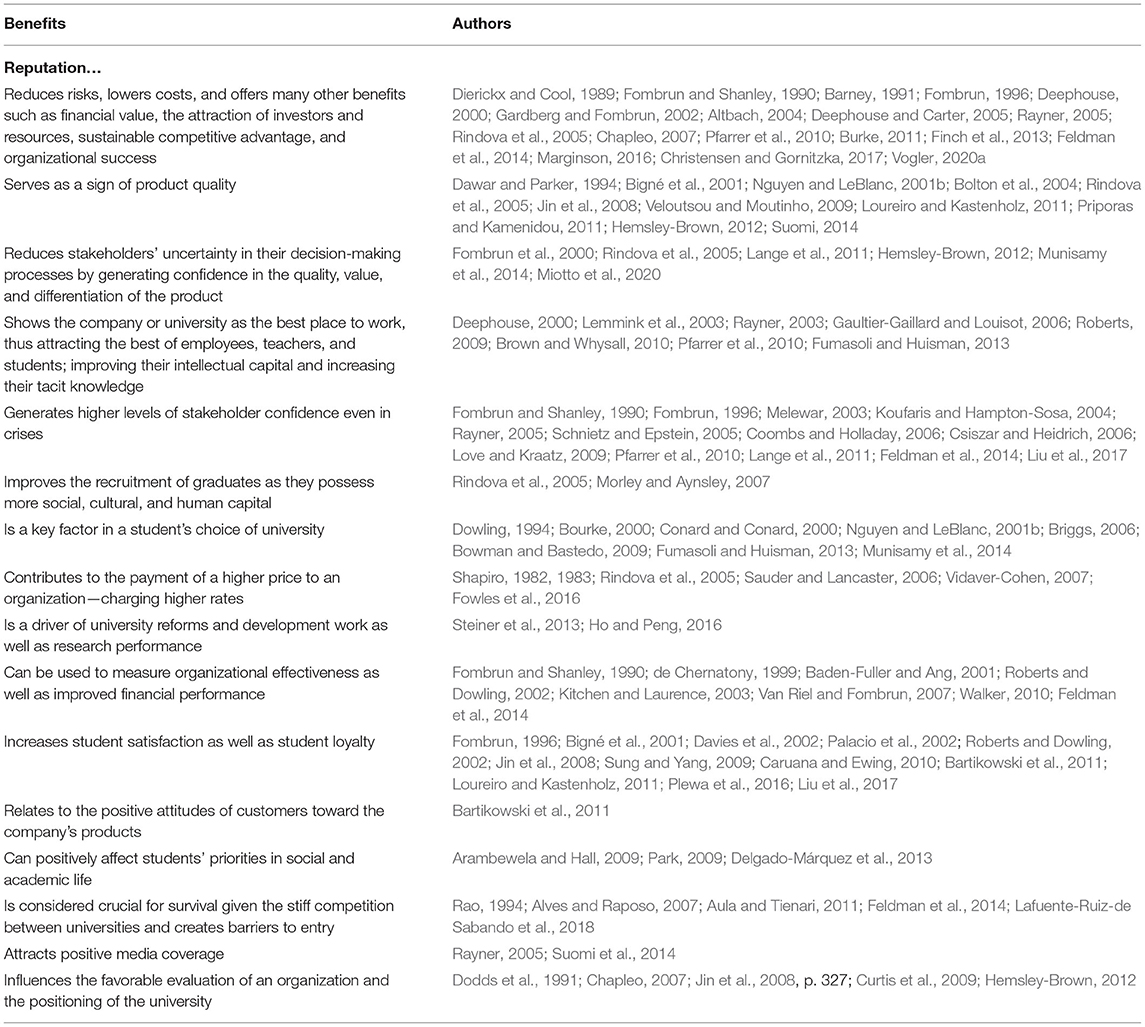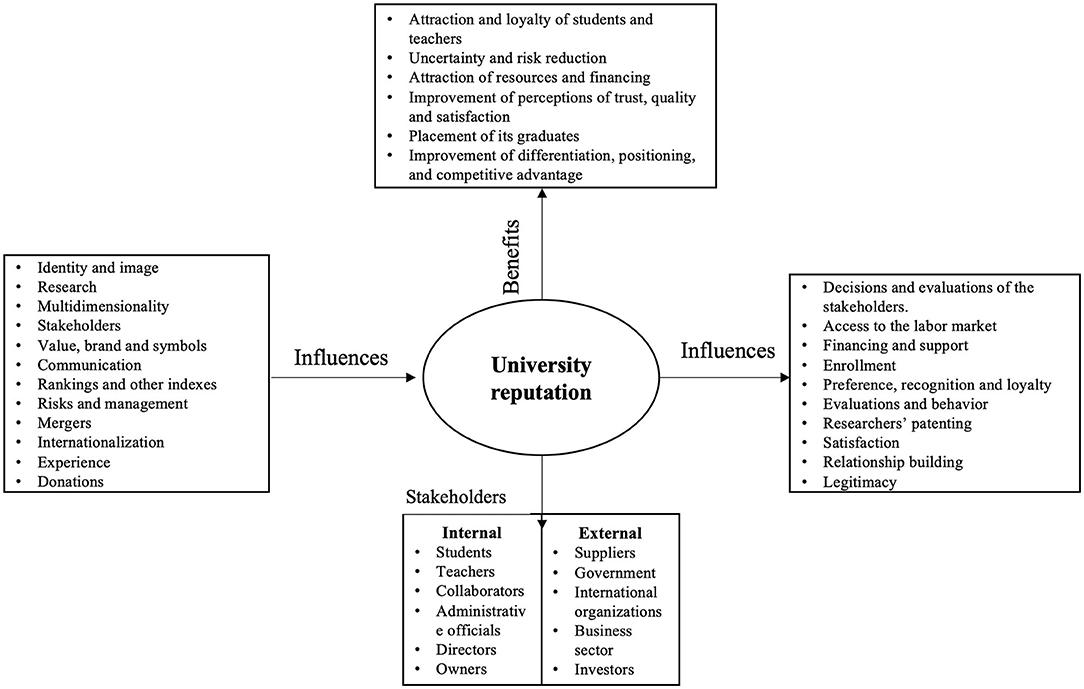- Business School, Universidad del Rosario, Bogotá, Colombia
Published research on corporate reputation has increased in the last 10 years in various sectors. The higher education sector is no stranger to this growth; however, theoretical developments and empirical research have been conducted across various disciplines of knowledge and theoretical approaches, which has made it difficult to theorize about it. In addition to this, the dimensionality of the construct, its dependence on the perception of public interest, and the difficulty of its measurement have made it a challenge for universities. This article develops a systematic review of reputation in higher education institutions. While there is evidence of contributions in the development of the theory and its conceptualization, these have occurred in other sectors such as banking, service industries, retailing, tourism and hospitality, and are not specifically focused on the higher education sector. As such, we seek to identify and characterize how reputation has been studied in this sector, highlighting conceptual and theoretical approaches that have supported the studies, which will help to overcome the fragmentation of the same from an integral definition applied to the education service.
Introduction
The concept of corporate reputation dates back to the 1970s when the relevance of the different assessments made by stakeholders of the company's reputation began to be identified (Spence, 1973) and the importance of public reputational signals for company performance and competitiveness became evident (Caves and Porter, 1977). Reputation is beginning to be understood as a group of attributes and characteristics of an organization that are the result of its past actions (Weigelt and Camerer, 1988), of the evaluation of the organization's performance (Rao, 1994; De Quevedo et al., 2005) and the perceptions that stakeholders have of them (Fombrun, 1996, p. 72), through a process of legitimization (Miotto et al., 2020).
Thus, a positive reputation can impact financial performance, customer behavior (Jung and Seock, 2016), competitiveness (Fombrun, 1996), stakeholder decision-making (Hemsley-Brown, 2012), corporate survival and success (Christensen and Gornitzka, 2017) as well as the integration of general management functions (Goldring, 2015). As such, it is important to know how to manage reputation and better invest resources to improve stakeholder perceptions (Lafuente-Ruiz-de Sabando et al., 2018).
Within the university context, reputation is defined as the sum of the impressions received by stakeholders from the communication and interaction they have with the university (Rindova et al., 2005), therefore it is evaluative, reflects consensus judgments (Roberts and Dowling, 2002), is related to a “strong tradition” (Chevalier and Conlon, 2003) and, like organizational reputation, it takes time to consolidate a positive reputation in its stakeholders and therefore requires an institutional commitment to excellence in educational processes and results, as well as in research results (Roberts and Dowling, 2002; Arambewela and Hall, 2009; Delgado-Márquez et al., 2013). Although reputation is linked to research productivity, this indicator is widely criticized because of its limitation, in addition, as expressed by Nicholas et al. (2015), reputation is evaluated with only one activity, which is research, the product of which are articles and the product of these articles, citations.
Reputation is built through the student's experience with the university (Chen and Esangbedo, 2018), and influences student attraction (Plewa et al., 2016), student selection of the university (Lafuente-Ruiz-de Sabando et al., 2018), faculty attraction (Christensen and Gornitzka, 2017), the knowledge held by stakeholders (Vogler, 2020a) both internally and externally (Verčič et al., 2016), as well as the valuation and rating of universities (Del-Castillo-Feito et al., 2019). In addition, previous studies have found that reputation requires management and has an important impact on the internal processes carried out by the university, including university reforms (Steiner et al., 2013), which have a significant effect on the quality of the university's educational service. Within such management, the media play an important role, because they provide the channel and space where stakeholders know, identify, give their opinion and discuss the reputation of an institution (Deephouse, 2000). This is why more and more universities faced with a competitive context, turn to marketing to improve the perception of their image and reputation, in order not only to attract students, but also teachers and financial resources (Wilkins and Huisman, 2014).
From this perspective, as stated by Reznik and Yudina (2018), reputation is a public evaluation, product of the opinion that stakeholders have of the university, and that can be divided into internal and external, the internal referring to the faculty, administrative staff and students, and external referring to representatives of the external environment. Therefore, reputation management implies an important knowledge of how it is built, and how the different stakeholders (both internal and external) perceive and evaluate it (Ressler and Abratt, 2009). In short, it is essential to know how to respond and meet the expectations and needs of each stakeholder and make it a strategic priority for university managers.
However, inconsistencies have been evidenced in the conceptualization of reputation in the higher education sector given the rules of operation in the education sector are different to those in the other corporate sectors (Verčič et al., 2016) and the absence of a consensus in the literature (Plewa et al., 2016; Del-Castillo-Feito et al., 2019) in management research (Ali et al., 2015; Veh et al., 2019), as well as its proximity to other terms such as identity and image (Alessandri et al., 2006; Lafuente-Ruiz-de Sabando et al., 2018) which are different but interconnected constructs. The identity is a multidimensional construct composed of communication and visual identity, behavior, culture, and market conditions (Melewar and Akel, 2005), and image is also a higher order multidimensional concept that can be managed to influence other variables such as student satisfaction and loyalty (Lafuente-Ruiz-de Sabando et al., 2018). Additionally, other factors that make its definition difficult are intangibility (Nguyen and Leblanc, 2001a), given the reputation of the university is the result of the provision of the education service that is essentially intangible and difficult to evaluate in advance. The multidimensionality (Verčič et al., 2016) since the reputation is composed of multiple dimensions such as performance, product, service, leadership, governance, workplace, citizenship, and innovation (Vidaver-Cohen, 2007), especially with regard to origins of corporate reputation research (Veh et al., 2019), and the assessments of the different stakeholders (Plewa et al., 2016) that respond to their different expectations (Vidaver-Cohen, 2007).
Although the contributions found in the systematic review conducted by Lafuente-Ruiz-de Sabando et al. (2018) who have sought to differentiate the concepts of image and reputation in higher education institutions (HEIs), the analyses carried out allowed them to conclude that the stakeholders of a university's academic offerings, such as teaching and research resources, graduate education, and affective image have a positive and significant influence on the image of the university, and that this assessment varies to the extent that the various perspectives of the stakeholders are adopted, and even more so when citizens of other countries are included. The contributions of Rashid and Mustafa (2021) who have studied the background of corporate reputation of higher education institutions by recognizing it as an intangible asset in all types of organizations, including HEIs, from the employees' perspective, and Prakash (2021) who conducted a literature review on the concept of service quality in higher education institutions where he inquired among several things on the methodologies to measure quality, and found that in some of them, reputation is an important dimension to measure to operationalize it. However, it is necessary to continue investigating its conceptual development, characteristics, tools and relationships with other variables within the context of higher education.
Given the above factors, and the diversity and fragmentation of this concept specifically in the context of higher education, where the contributions are still insufficient (Watkins and Gonzenbach, 2013; Del-Castillo-Feito et al., 2019), it is necessary to conduct a systematic review on reputation in universities (HEIs) with three objectives. First, to understand how empirical reputation research [these studies might be quantitative, qualitative, or mixed methods studies (Creswell, 2014)] in these institutions has been characterized. This will be conducted through a bibliometric analysis using the SciVal tool of Elsevier; second, to identify the variables and/or constructs related to reputation. This will be performed through an analysis using the VOSviewer tool and a direct review of the documents; third, to determine how reputation has been conceptualized in HEIs. This will also be approached through a direct review of documents using the four-eyes principle to avoid bias. These objectives will provide an overview of the construct, and a comprehensive picture to improve the understanding of the university's reputation.
This article begins with a description of the methodology used, then presents the characterization of the articles reviewed, followed by an analysis of the relationships found concerning reputation. This is followed by a compilation of the definitions of corporate reputation—specifically those applied to higher education—and its benefits and weaknesses. Finally, the conclusions, limitations of the research, and the agenda for future research are presented.
Methods
This paper will use a systematic literature review based on previous studies, as a method of analysis of empirical research conducted on reputation in HEIs. This allows a broad and continuous review of the literature, providing a frame of reference to compare the results of this study with previous ones (Creswell, 2014, p. 60). Such a study is also used to find relevant information in the selected context (Aveyard, 2014) and is fundamental in academic works (Lunde et al., 2019), and scientific activities (Mulrow, 1994) in management. Among the benefits of conducting a systematic literature review is understanding the theoretical relationship between the problem to be investigated, the objectives and, the discussion (Rocco and Plakhotnik, 2009). It also facilitates the identification, evaluation, and summary of findings of relevant studies on the topic, providing a strong foundation for the research, which will result in better development of the different investigations and their relationship with the conclusions (Centre for Reviews Dissemination, 2008).
Petticrew and Roberts (2006) propose a methodology for developing systematic reviews, consisting of the following steps: (1) define the question driving the review, (2) determine the types of studies that need to be addressed to answer the questions, (3) conduct a comprehensive literature search, (4) examine results with inclusion and exclusion criteria, (5) develop a critical appraisal of the studies included to ensure that key aspects of the study are addressed, (6) synthesize the studies and assess the heterogeneity of the findings, and (7) disseminate the conclusions of the review.
Question Formulation
Step 1. Define the Question That Directs the Review
For the development of the first step, the questions posed that will direct the review are: How have empirical studies of reputation in higher education institutions been characterized? Based on this characterization, with which variables and/or constructs has it been related? How has reputation in higher education services been conceptualized? The results will contribute to the identification of a comprehensive overview in order to improve the academic and administrative community's understanding of the implications of reputation management. Figure 1 presents a summary of the methodological steps, the questions guiding the work, and the results of the analysis that respond to the questions posed.
Article Selection
Step 2. Determine the Types of Studies to Be Addressed
To comply with the second step, the types of studies included in this review are empirical research articles and systematic reviews applied to the higher education sector and published in journals categorized in quartiles 1 and 2, which represent a higher impact factor and quality (Marín and Arriojas, 2021). Critical analyses, editorials, or essays are omitted.
Step 3. Conduct an Exhaustive Literature Search
In this step, a search is performed in Scopus and Web of Science (WoS) over a period of 10 years (2010–July 2020), as it is considered sufficiently extensive for the review and is consistent with the indicator of obsolescence of the scientific literature (Price, 1965). Also, these years show the highest number of publications on the subject as will be seen below. The language selected for the review of the articles is English because it is the most recurrent language in the documents of the selected databases considering as keywords: reputation, higher education, university(ies).
In the WoS database, two searches were performed, the first with reputation and higher education, the second with reputation and university; for the Scopus database, reputation, higher education, or universities or university1 was used. Subsequently, we proceeded to search and download the documents in the WoS and Scopus databases, of which only five could not be accessed.
Step 4. Examine the Results With Inclusion and Exclusion Criteria
For the development of the fourth step, Figure 2 shows the result of the screening and consolidation of the two searches and the selection process of the articles, indicating the inclusion and exclusion criteria that were taken into account following the PRISMA methodology.
Step 5. Develop a Critical Appraisal of the Studies Included
Once the selection process is completed a critical and taxonomic assessment of the 62 selected articles is carried out. This provides relevant information to answer the research questions posed, evolved from the review of the definitions on which the studies are based; the variables with which they are related; the theories on which the studies are based; the measurement methods identified; as well as the benefits and weaknesses found in reputation management. To present the characterization of the 62 articles found from the process described above, this research performs a bibliometric analysis through Elsevier's SciVal tool, used to analyze the behavior of research in a particular field, make comparisons, associations, identify trends and create reports (Elsevier, 2022). We also use the VOSviewer, which is a program created to build and visualize bibliometric networks (VOSviewer, 2022). In addition, we perform an analysis of texts collected by a reviewer and verified by another researcher, using the four-eyes principle, to reduce the risk of bias (Hiebl, 2015).
Results
How Have the Empirical Studies of Reputation in Higher Education Institutions Been Characterized?
Using Elsevier's SciVal tool, in March 2022, we analyzed the publications per year within the time range addressed in the study (2010–July 2020), the citation behavior, the Field-Weighted Citation Impact (FWCI), which is the impact of citations obtained compared to the average number of citations expected in the subject field (Elsevier, 2020), citation behavior data by year, publications by journal quartile, and an analysis of the institutions, their type, country of publication and journals.
The number of articles on reputation in higher education institutions has been increasing in the last 10 years, as shown in Table 1, where it is evident that the year with the highest number of articles is 2018 with 13 publications, followed by 2019 with 12 publications, and 11 publications as of July 2020.
It is observed that the years with the highest number of citations were 2011 (219 citations) and 2016 (191 citations), as shown in the table. This trend had an impact on the weighted citations per field, which are 3.88 in 2011, and 3.89 in 2016, the highest evidenced in the period studied. This shows the importance of reputation in the field of study, which may be due to the international collaborations that occurred in those years, as can also be seen in Table 1.
In turn, a review of the impact of the quartiles in the publications analyzed within the period studied was carried out, showing that 90.3% of the articles on their date of publication were in journals categorized within the Q1 and Q2 quartiles2 (37 and 19 articles, respectively). It should be clarified that on the date the quartiles of the publications were searched, some of them had improved their performance, placing them in the first two quartiles. Since 2018 there is a growth in the number of articles published on this subject, and in 2016 all published articles are in the Q1 category, as evidenced in the results presented in Figure 3.
In contrast, the institutions with the highest academic production, citations, and authors researching and writing on the subject of reputation were reviewed, and it was found that the University of Turku in Finland, the Universidad Rey Juan Carlos in Spain, and the University of Michigan, Ann Arbor in the United States had the highest academic production with three articles each. However, the articles from the University of Michigan are the most cited of the three universities. It also had the highest number of citations among the institutions analyzed, followed by the University of Notre Dame with 227 citations, and Rice University and the University of Georgia with 116 citations each, as shown in Figure 4. In terms of the number of authors per institution publishing the most on reputation are Florida State University with five authors, and Mount Royal University, University of Salerno, Indonesia University of Education and, Zhejiang Sci-Tech University with four authors each.
Within this same analysis, a review was made of the publications by each country, their academic production, and the Field-Wide Citation Impact (FWCI). Figure 5 shows 26 countries where research has been done on reputation in higher education institutions, with the most representative in terms of academic production being the United States (32), United Kingdom (17), Spain (8), and China (6). The two countries with the highest impact factor are Iran (7.15) and the United Arab Emirates (3.47), which may be related to academic production or its quality, followed by Finland (2.60), Ireland (3.56), and Australia (2.52). It is worth mentioning that of the 98 institutions that participated in the publication of the articles analyzed, 94 correspond to higher education institutions, three to governmental entities and, one to independent corporate research entity.
Finally, a review of the journals with the highest number of articles on reputation in higher education was carried out, and it was found that Studies in Higher Education (Q1), Corporate Reputation Review (Q2), Higher Education (Q1), International Journal of Educational Management (Q2), Journal of Business Research (Q1) are the journals that have published the highest number of articles. The four most representative journals that have published at least three articles on the subject of reputation are Corporate Reputation Review, Higher Education, International Journal of Educational Management, and Journal of Business Research.
Synthesis of the Articles Reviewed
Step 6. Synthesize the Studies and Assess the Heterogeneity of the Findings
To synthesize the content of the articles found, (Table 2) below summarizes their structural characteristics in terms of the methods used to approach the research, the types of variables or the way of analyzing reputation, the units of study used in the articles, the theories that underpinned the research and the collection tools.
With Which Variables and/or Constructs Has It Been Related?
To evaluate the heterogeneity of the findings, a descriptive analysis of the concept of reputation is carried out. First, to understand the main relationships and co-occurrence of the terms found in the articles, the co-occurrence map of the VOSviewer tool was used, where the titles and abstracts of the 62 articles were reviewed. The program helped visualize four different but interrelated clusters. Each of the terms found is represented by a node and its size corresponds to its relevance. Each node has a color; in this case, the red node will be called cluster 1, the green node cluster 2, the blue node cluster 3, and the yellow node cluster 4. The intensity of the color will reflect the relevance of the relationship (Cantos-Mateos et al., 2013). Based on this score, 65% of the most relevant terms were selected (5% more than suggested by the system to increase the number of items), with a total of 18 terms grouped as follows: cluster 1, higher education institution, image, legitimacy, relationship, reputation, stakeholder. Cluster 2, academic reputation, college, impact, institution, ranking. Cluster 3, effect, information, news medium, university, university reputation. Cluster 4, reputation management, use. Figure 6 shows the co-occurrence map.
From a detailed analysis of the composition of each of the clusters based on the thematic focus of the articles, it can be inferred that the articles in cluster 1 (red) focus on highlighting the importance of the relationship with stakeholders, the projected image and legitimacy; the articles in cluster 2 (green) analyze the impact of rankings on institutions and academic reputation; those in cluster 3 (blue) study the effect of information and the media on university reputation; and cluster 4 (yellow) includes the management and use of reputation. The following is a proposal that groups the articles reviewed in each of the four clusters found.
Cluster 1: Relationship With Stakeholders, Projected Image, and Legitimacy
In this cluster, we find studies such as the relationship of proximity, stakeholders, and reputation (Finch et al., 2015); the multidimensionality of reputation through stakeholders (Verčič et al., 2016); the use of social networks, reputation, and stakeholders (Carrillo-Durán and García, 2020); the influence of university identity, image on reputation (Steiner et al., 2013); identity and image management on reputation (Maduro et al., 2018); the relationship between image, legitimacy, and reputation (Del-Castillo-Feito et al., 2019, 2020); co-creation of value, image and reputation (Foroudi et al., 2019, 2020); reputation and image (Lafuente-Ruiz-de Sabando et al., 2018).
Cluster 2: The Impact of Academic Rankings and Reputation on Institutions
In this cluster is the influence of rankings on reputation (Bastedo and Bowman, 2010; Bowman and Bastedo, 2011); the Google Ngram viewer and reputation (Stergiou and Tsikliras, 2013); athletic rankings and reputation (Bouchet et al., 2017); the average h-index as a predictor of reputation as measured via the U. S. News & World Report (Smith et al., 2018); reputation as a result of citation networks via PageRank (Massucci and Docampo, 2019); the influence of ranking, credibility signals and reputation on student selection (Haas and Unkel, 2017); the impact of reputation and rankings on teaching income (Wolf and Jenkins, 2018).
Cluster 3: The Effect of Information and Media on University Reputation
The following papers are part of cluster 3: university resources, public relations and news content (Lee et al., 2015); communication strategy and reputation (Sataøen and Wæraas, 2016); the importance of media on reputation and stakeholders (Vogler, 2020a); university mergers influence reputation (Aula and Tienari, 2011); research-related activities and reputation (Jamali et al., 2016); reputation as a source of information influences managers' (Martin et al., 2018) and students' (Brewer and Zhao, 2010; Priporas and Kamenidou, 2011; Munisamy et al., 2014; Lee et al., 2018) decisions; reputation, tribalism, use of Facebook in relationship building (Liu et al., 2017); effects of reputation in the media on third-party funding (Vogler, 2020b).
Cluster 4: The Management and Use of Reputation
Finally, this cluster is formed by reputation and risk management (Reznik and Yudina, 2018); the identification and management of reputation risks (Suomi and Järvinen, 2013); university performance, reputation and professional staff (Baltaru, 2020); university resource management - multidimensionality of reputation (Suomi, 2014; Plewa et al., 2016; Chen and Esangbedo, 2018; Esangbedo and Bai, 2019); performative, moral and professional symbols as categories of reputation management (Christensen and Gornitzka, 2017).
Relationships Found in the Review of the Articles
To deepen the relationships found in the papers reviewed, an analysis of the typology of the variable reputation or the direction of influence attributed to reputation was performed. In addition, the variables commonly studied together with university reputation were grouped by similar themes. Figure 7 shows the variables that influence reputation and Figure 8 shows the variables on which reputation has some type of influence.
The following are the variables on which reputation has an influence or impact:
The papers also found other variables to which reputation was related: career prospects (Munisamy et al., 2014); entry standards (Drydakis, 2015); motivation to study abroad (Lee et al., 2018); tribalism (Liu et al., 2017); voice-to-voice (Harahap et al., 2018); quality of life (Alter and Reback, 2014); personality and brand attachment (Kaushal and Ali, 2019); co-creation (Foroudi et al., 2019, 2020); proximity and strategic character (Finch et al., 2015).
How Has Reputation Been Conceptualized in Higher Education Services?
In each of the 62 articles, the concept of reputation and the authors with the highest number of citations were reviewed; and Fombrun was found to be the most cited author in the literature. Fombrun (1996) has nine direct citations and at least 16 others with various authors: Fombrun and Shanley (1990)—six citations, Fombrun et al. (2000)—four citations, Fombrun and Van Riel (1997, 2003, 2004); Van Riel and Fombrun (2007)—eight citations. They are followed by Rindova et al. (2005) who have at least 14 direct citations not counting those with other authors in 2010. Next is Suomi (Järvinen and Suomi, 2011; Suomi and Järvinen, 2013; Suomi, 2014; Suomi et al., 2014), with nine citations in total. Then there is Alessandri et al. (2006) who presents eight citations.
Most of these authors, define reputation at the organizational level. As such, it is common to find that their “corporate” definition applies to different sectors of the economy. This behavior was observed in a large part of the articles reviewed since some researchers chose to take up the organizational definition to support their research works that were applied to the higher education sector. In this sense, it is important to mention that globalization and the intensification of competition have caused universities to lose their social and formative focus, and become producers of competitive services by adopting more market-oriented approaches (Maringe and Gibbs, 2009, p. 4). Therefore, a summary of the definitions found was made, which is listed in Table 3 (the complete list can be found in the Supplementary Material).
Although it is common to find the aforementioned definitions in research works, some authors have adapted the definition of reputation and applied it to the higher education service, since they understand the characteristics and particularities that differentiate it from other services. The definitions found in the review focus on showing the importance of the interaction of stakeholders with the university (Rindova et al., 2005; Chen and Esangbedo, 2018) over time (Alessandri et al., 2006, p. 261) and the incidence of opinions of third-party experts (Roberts, 2009). They also focus on showing the social and economic capital it generates (Federkeil, 2009, p. 32), taking into account that it is a valuable asset that influences differentiation and competitive advantage (Luque-Martínez and Del Barrio-García, 2009). Further, it also serves as a proxy for assessing university quality. Therefore, it influences university selection and evaluation (Hemsley-Brown, 2012; Munisamy et al., 2014) and the trustworthiness of its image (Van Vught, 2008, p. 169), attracting and retaining students (Munisamy et al., 2014). From a student's perspective, public relations, marketing communication, crisis and/or risk management, and corporate branding perspectives are key (Maringe and Gibbs, 2009). A summary of the definitions of university or higher education reputation is shown in Table 4 (see Supplementary Material).
Benefits and Weaknesses of Reputation
Reputation generates a huge impact both for universities and companies in other sectors. As such, we analyzed its benefits and weaknesses, considering the importance of examining both sides of the coin and identifying where the most important challenges in the conceptualization and management of reputation lie. Table 5 shows a summary of the main benefits attributed to reputation, and the authors cited.
As regards the weaknesses of reputation referred to in the articles, the authors mention that Reputation Cannot be Improved Quickly (de Chernatony, 1999; Chun, 2005), and Lacks a Common definition regarding which no consensus has been reached yet (Miotto et al., 2020). Further, it presents a lack of clarity regarding its management and remains a challenge for universities (Šontait and Bakanauskas, 2011). It shows a degree of complexity within which the following aspects can be highlighted: heterogeneity in terms of stakeholders and, as a consequence, differences in their expectations (Vidaver-Cohen, 2007; Suomi and Järvinen, 2013). When reputation is not successfully managed in the organization it is exposed to numerous risks (Suomi and Järvinen, 2013). In universities specifically, where it is understood as the quality of education, reputation is difficult to evaluate before being experienced (Suomi et al., 2014).
Summary of Findings
Taking into account the above findings, an outline is made with the most relevant points in the definition of university reputation. This is done with the understanding that it is the result of assessments made by both internal and external stakeholders of the performance and results obtained in the management of its substantive functions, namely, teaching, research, and extension during a given period. Internal stakeholders include students, graduates, teachers, researchers, administrative and managerial staff, with the student being the main beneficiary of the educational service (Maringe and Gibbs, 2009, p. 29). External stakeholders include students' families and friends, research centers, private and public business sectors, the state, rankings, and suppliers, among others. Figure 9 shows the results graphically.
Conclusions
The methodology developed for the literature search on reputation in higher education resulted in 231 articles. Not all of them were included taking into account the exclusion criteria within the screening process. However, it did allow for observing the growing interest in this topic given the impact it has on organizations, in this case, in the higher education sector.
In addition, and as expected, definitions of organizational reputation were adopted and applied to the processes of university reputation management. However, some authors chose to make adaptations of these definitions to the context of higher education institutions, emphasizing the importance of identification and relationship with stakeholders (Finch et al., 2015; Verčič et al., 2016; Zavyalova et al., 2016; Martin et al., 2018; Carrillo-Durán and García, 2020), understanding the differences between the needs and knowledge that each one has of the organization, as well as underscoring the concern over the time it takes to develop a solid reputation in the market (Brewer and Zhao, 2010; Loureiro et al., 2017), which is different and generates value and competitive advantage (Burke, 2011; Feldman et al., 2014; Munisamy et al., 2014; Marginson, 2016). As regards reputation built over time, universities must compete to gain a position (Chapleo, 2007) in the local, national and international markets, which are becoming more complex, given the impact that rankings—which have become a benchmark of the quality of universities—have on the valuation of stakeholders (Bowman and Bastedo, 2011; Drydakis, 2016; Wolf and Jenkins, 2018).
Therefore, it was found that reputation is decisive in the student's shopping experience (Handayani, 2019; Pitan and Muller, 2019), which includes university selection, influencing, their lived experience in the training process (Sajtos et al., 2015), placement or job attainment rates (Smith et al., 2008; Laker and Powell, 2011; Finch et al., 2013), and development of entrepreneurship (Parente et al., 2015). From the institutional point of view and within the framework of the purchasing experience, reputation management also helps in areas such as retention of students (Del-Castillo-Feito et al., 2019), relationships with the business sector, agreements with other educational institutions, advancement of research (Morphew et al., 2016), exchanges at the national and international level (Plewa et al., 2016), and relations with the media (Deephouse, 2000), etc.
To capitalize on each of these findings, Figure 9 shows a compendium of the points considered most relevant in the search, on the variables that influence reputation, the variables that are influenced by reputation, its benefits, and main stakeholders categorized as internal and external, following Verčič et al. (2016, p. 165). In the evaluations made by external stakeholders, a critical point is the knowledge they have about the university given its proximity which influences their opinions that may be biased but have an impact on the reputation and quality of work of a university (Steiner et al., 2013). For its part, reputation management among internal stakeholders, mainly students, have a positive impact on their attitudes (Foroudi et al., 2019) and is a key element for the success and survival of universities (Christensen and Gornitzka, 2017), which currently operate in a complex and competitive environment, in which they must compete with other HEIs for access to different resources and meet the expectations of all their stakeholders.
Discussion and Agenda for Future Research
The challenges of reputation management in educational institutions are evident in the literature review addressed. Issues such as the increase in academic offerings in terms of scope and variety of programs (Maringe and Gibbs, 2009), changes in funding structures (Steiner et al., 2013), internationalization of education (Plewa et al., 2016), globalization and mobility of students and faculty (O'Loughlin et al., 2013), as well as the focus on achieving high quality certifications as a strategy to show university differentiation and influence the images received by the various stakeholders, especially the student as the main user of the service, are crucial issues for university competitiveness. In fact, it is important to clarify that reputation and quality are related, but not necessarily identical (Van Vught, 2008). In addition, authors such as Roberts (2009) point out that, in order to achieve the main objective of the university, in terms of offering a high quality service that responds to the needs of society, it is necessary and indispensable to work together and articulate between employees and departments with mechanisms that support management to achieve a positive reputation.
This management implies that universities adapt to these new models and systems of evaluation and measurement to show indicators of academic quality (Steiner et al., 2013), which is why managers also focus their attention on improving their performance in the different rankings (O'Loughlin et al., 2013). Among the prominent rankings to measure the reputation of the most prestigious universities in the world, are the Academic Ranking of World University ARWU (also known as the Shanghai ranking), the British ranking Times Higher Education -THE, and the Quaquerelli Symonds–QS. Each of them has different indicators and weights in their measurement. The ARWU for example, takes into account graduates and teachers with Nobel Prizes and Fields Medals, the most cited researchers, the amount of indexed articles and their respective citations. However, these rankings have been criticized for their focus on the research capacity of universities and the way in which the individual indicators used to obtain the synthetic indicator are weighted (Parellada and Álvarez, 2017). And indeed they have had an impact on the “publish or perish” message received by university faculty and professors, further evidencing the value of research (Linton et al., 2011). Despite the negative biases of this type of measurement, rankings remain an important variable that influences reputation and, in fact, is consolidated in cluster 2, found in this study.
Subsequent research work can focus on further developing and understanding the multidimensionality of the concept of university reputation, in the light of a theoretical corpus that continues to evolve based on the characteristics and particularities of higher education and the challenges posed by the social, economic, political, and environmental contexts in which it develops its substantive functions. They will also be able to validate the relationships between the variables found, as well as to propose new variables that have not been contemplated and that may have an important and predictive impact on the performance of the construct.
Limitations
This review focused on a 10-year period, by analyzing two databases, WoS and Scopus. As such, other databases that might contain articles on university reputation were not considered. Similarly, we did not include languages other than English, given that the number of documents found in the searches was sufficiently extensive only in that language. Besides, as mentioned earlier, most of the literature is in English. Further, articles indexed in journals located in quartiles 3 and 4 were not taken into account. As such, articles that may have contributions or theoretical perspectives different from those found could have been omitted. Furthermore, it is understood that a sample of 62 articles is only a part of all the literature found on reputation in universities and that a broader more inclusive review could generate different conclusions. However, this systematic review was carried out exhaustively, analyzing each of the documents found to generate the results presented here.
Data Availability Statement
The original contributions presented in the study are included in the article/Supplementary Material, further inquiries can be directed to the corresponding author.
Author Contributions
FJ contributed to design of the study and supervised both the development of the research and the manuscript. MA completed the majority of the literature review and wrote the first draft. Both authors contributed to the article and approved the submitted version.
Funding
The publication of this article was supported by the Research Department, School of Business, Universidad del Rosario.
Conflict of Interest
The authors declare that the research was conducted in the absence of any commercial or financial relationships that could be construed as a potential conflict of interest.
Publisher's Note
All claims expressed in this article are solely those of the authors and do not necessarily represent those of their affiliated organizations, or those of the publisher, the editors and the reviewers. Any product that may be evaluated in this article, or claim that may be made by its manufacturer, is not guaranteed or endorsed by the publisher.
Supplementary Material
The Supplementary Material for this article can be found online at: https://www.frontiersin.org/articles/10.3389/feduc.2022.925117/full#supplementary-material
Footnotes
1. ^Boolean code used in Web of Science: TITLE: (reputation) AND SUBJECT: (higher education) and the second TITLE: (reputation) AND SUBJECT: (university). In the Scopus database, the following Boolean code was used: [TITLE (reputation) AND TITLE (higher AND education) OR TITLE (universities) OR TITLE (university)] AND DOCTYPE (ar OR re) AND PUBYEAR > 2009.
2. ^Taking into account the SCImago Journal Rank (SJR), which weights the value of a citation based on the subject field, quality and reputation of the source (Elsevier, 2020).
References
Alessandri, S., Yang, S., and Kinsey, D. (2006). An integrative approach to university visual identity and reputation. Corp. Reputation Rev. 9, 258–270. doi: 10.1057/palgrave.crr.1550033
Ali, R., Lynch, R., Melewar, T. C., and Jin, Z. (2015). The moderating influences on the relationship of corporate reputation with its antecedents and consequences: a meta-analytic review. J. Bus. Res. 68, 1105–1117. doi: 10.1016/j.jbusres.2014.10.013
Altbach, P. G. (2004). Globalisation and the university: myths and realities in an unequal world. Tert. Educ. Manage. 10, 3–25. doi: 10.1080/13583883.2004.9967114
Alter, M., and Reback, R. (2014). True for your school? How changing reputations alter demand for selective U.S. colleges. Educ. Eval. Policy Anal. 36, 346–370. doi: 10.3102/0162373713517934
Alves, H., and Raposo, M. (2007). Student satisfaction index in portuguese public higher education. Serv. Indust. J. 27, 795–808. doi: 10.1080/02642060701453288
Arambewela, R., and Hall, J. (2009). An empirical model of international student satisfaction. Asia Pac. J. Mark. Log. 21, 555–569. doi: 10.1108/13555850910997599
Aula, H. M., and Tienari, J. (2011). Becoming world-class? Reputation-building in a university merger. Crit. Perspect. Int. Bus. 7, 7–29. doi: 10.1108/17422041111103813
Aveyard, H. (2014). Doing a Literature Review in Health and Social Care A Practical Guide, Vol. 18, 3rd Edn. England: McGraw Hill Education.
Baden-Fuller, C., and Ang, S. H. (2001). Building reputations: the role of alliances in the european business school scene. Long Range Plann. 34, 741–755. doi: 10.1016/S0024-6301(01)00088-7
Baltaru, R. D. (2020). The rise of agentic inclusion in the UK universities: maintaining reputation through (formal) diversification. Stud. High. Educ. 47, 229–242. doi: 10.1080/03075079.2020.1739015
Barney, J. (1991). Firm resources and sustained competitive advantage. J. Manage. 17, 99–120. doi: 10.1177/014920639101700108
Bartikowski, B., Walsh, G., and Beatty, S. (2011). Culture and age as moderators in the corporate reputation and loyalty relationship. J. Bus. Res. 64, 966–972. doi: 10.1016/j.jbusres.2010.11.019
Bastedo, M. N., and Bowman, N. A. (2010). U.S. News and world report college rankings: modeling institutional effects on organizational reputation. Am. J. Educ. 116, 163–183. doi: 10.1086/649437
Bigné, J. E., Sánchez, M. I., and Sánchez, J. (2001). Tourism image, evaluation variables and after purchase behaviour: inter-relationship. Tour. Manage. 22, 607–616. doi: 10.1016/S0261-5177(01)00035-8
Bolton, G. E., Katok, E., and Ockenfels, A. (2004). How effective are electronic reputation mechanisms? An experimental investigation. Manage. Sci. 50, 1587–1602. doi: 10.1287/mnsc.1030.0199
Bouchet, A., Laird, M. D., Troilo, M., Hutchinson, M., and Ferris, G. (2017). Effects of increased commitment on reputation and status: evidence from NCAA Division I universities. Sport Manage. Rev. 20, 395–407. doi: 10.1016/j.smr.2016.11.002
Bourke, A. (2000). A model of the determinants of international trade in higher education. Serv. Indust. J. 20, 110–138. doi: 10.1080/02642060000000007
Bowman, N. A., and Bastedo, M. N. (2009). Getting on the front page: organizational reputation, status signals, and the impact of U.S. news and world report on student decisions. Res. High. Educ. 50, 415–436. doi: 10.1007/s11162-009-9129-8
Bowman, N. A., and Bastedo, M. N. (2011). Anchoring effects in world university rankings: exploring biases in reputation scores. High. Educ. 61, 431–444. doi: 10.1007/s10734-010-9339-1
Brewer, A., and Zhao, J. (2010). The impact of a pathway college on reputation and brand awareness for its affiliated university in Sydney. Int. J. Educ. Manage. 24, 34–47. doi: 10.1108/09513541011013033
Brewer, D., Gates, S., and Goldman, C. (2001). In Pursuit of Prestige: Strategy and Competition in U.S. Higher Education. Somerset, NJ: Technical Papers.
Briggs, S. (2006). An exploratory study of the factors influencing undergraduate student choice: the case of higher education in Scotland. Stud. High. Educ. 31, 705–722. doi: 10.1080/03075070601004333
Bromley, D. (1993). Reputation, Image, and Impression Management, 1st Edn. Chichester: John Wiley & Sons.
Bromley, D. (2000). Psychological aspects of corporate identity, image and reputation. Corp. Reputation Rev. 3, 240–252. doi: 10.1057/palgrave.crr.1540117
Bromley, D. (2002). Comparing corporate reputations: league tables, quotients, benchmarks, or case studies? Corp. Reputation Rev. 5, 35–50. doi: 10.1057/palgrave.crr.1540163
Brown, M., and Whysall, P. (2010). Performance, reputation, and social responsibility in the UK's financial services: a post-credit crunch interpretation. Serv. Indust. J. 30, 1991–2006. doi: 10.1080/02642060903220931
Burke, R. J. (2011). “Corporate reputations: development, maintenance, change and repair,” in Corporate Reputation: Managing Opportunities and Threats, 1 Edn, eds J. R. Burke, G. Martin, and C. L. Cooper. London: Gower, 1–43.
Cantos-Mateos, G., Vargas-Quesada, B., Zulueta García, M. A., and Chinchilla-Rodríguez, Z. (2013). Estudio Comparativo Sobre la Visualización de Redes de Co-words a Través de los Descriptores Del Science Citation Index y de Medline. Oporto: Universidade do Porto, 173–189.
Carrillo-Durán, M. V., and García, M. (2020). Exploring the need for stakeholders' engagement through social networking sites to build the reputation of higher education organisations. High. Educ. Q. 74, 442–457. doi: 10.1111/hequ.12256
Caruana, A., and Ewing, M. T. (2010). How corporate reputation, quality, and value influence online loyalty. J. Bus. Res. 63, 1103–1110. doi: 10.1016/j.jbusres.2009.04.030
Caves, R., and Porter, M. (1977). From entry barriers to mobility barriers: conjectural decisions and contrived deterrence to new competition. Q. J. Econ. 91, 241–261. doi: 10.2307/1885416
Centre for Reviews and Dissemination (2008). Systematic Reviews. York: University of New York; New York Publishing Services Ltd.
Chapleo, C. (2007). Barriers to Brand Building in UK Universities? Int. J. Nonprofit Volunt. Sect. Mark. 12:23–32. doi: 10.1002/nvsm.271
Chen, C., and Esangbedo, M. O. (2018). Evaluating university reputation based on integral linear programming with grey possibility. Math. Prob. Eng. 2018, 5484326. doi: 10.1155/2018/5484326
Chevalier, A., and Conlon, G. (2003). Does It Pay to Attend a Prestigious University?. Institute of Labor Economics. Available online at: https://EconPapers.repec.org/RePEc:iza:izadps:dp848
Christensen, T., Gavrila, S. G., Ma, L., and Ramirez, F. O. (2020). Reputation management by Chinese universities: primary profile and comparative features. Public Adm. 98, 1027–1043. doi: 10.1111/padm.12679
Christensen, T., and Gornitzka. (2017). Reputation management in complex environments - a comparative study of university organizations. High. Educ. Policy 30, 123–140. doi: 10.1057/s41307-016-0010-z
Chun, R. (2005). Corporate reputation: meaning and measurement. Int. J. Manag. Rev. 7, 91–109. doi: 10.1111/j.1468-2370.2005.00109.x
Cole, M. S., and Bruch, H. (2006). Organizational identity strength, identification, and commitment and their relationships to turnover intention: does organizational hierarchy matter? J. Organ. Behav. 27, 585–605. doi: 10.1002/job.378
Conard, M., and Conard, M. (2000). An analysis of academic reputation as perceived by consumers of higher education. J. Mark. High. Educ. 9, 69–80. doi: 10.1300/J050v09n04_05
Coombs, T. W., and Holladay, S. J. (2006). Unpacking the halo effect: reputation and crisis management. J. Commun. Manage. 10, 123–137. doi: 10.1108/13632540610664698
Creswell, J. (2014). Research Design: Qualitative, Quantitative and Mixed Methods Approaches, 4th Edn.. Thousand Oaks, CA: Sage.
Csiszar, E., and Heidrich, G. W. (2006). The question of reputational risk: perspectives from an industry. Geneva Pap. Risk Insur. 31, 382–394. doi: 10.1057/palgrave.gpp.2510096
Curtis, T., Abratt, R., and Minor, W. (2009). Corporate brand management in higher education: the case of ERAU. J. Prod. Brand Manage. 18, 404–413. doi: 10.1108/10610420910989721
Davies, G., Chun, R., da Silva, R. V., and Roper, S. (2002). Corporate Reputation and Competitiveness. London: Routledge.
Dawar, N., and Parker, P. (1994). Marketing universals: consumers' use of brand name, price, physical appearance, and retailer reputation as signals of product quality. J. Mark. 58, 81–95. doi: 10.1177/002224299405800207
de Chernatony, L. (1999). Brand management through narrowing the gap between brand identity and brand reputation. J. Mark. Manage. 15, 157–179. doi: 10.1362/026725799784870432
De Quevedo, E., De la Fuente, J. M., and Delgado, J. B. (2005). Reputación corporativa y creación de valor. marco teórico de una relación circular. Invest. Euro. Direc. Econ. Empresa 11, 81–97. Available online at: http://dialnet.unirioja.es.ez.urosario.edu.co/servlet/oaiart?codigo=1357926
Deephouse, D. L. (2000). Media reputation as a strategic resource: an integration of mass communication and resource-based theories. J. Manage. 26, 1091–1112. doi: 10.1177/014920630002600602
Deephouse, D. L., and Carter, S. M. (2005). An examination of differences between organizational legitimacy and organizational reputation. J. Manage. Stud. 42, 329–360. doi: 10.1111/j.1467-6486.2005.00499.x
Del-Castillo-Feito, C., Blanco-González, A., and Delgado-Alemany, R. (2020). The relationship between image, legitimacy, and reputation as a sustainable strategy: students' versus professors' perceptions in the higher education sector. Sustainability 12, 1189. doi: 10.3390/su12031189
Del-Castillo-Feito, C., Blanco-González, A., and González-Vázquez, E. (2019). The relationship between image and reputation in the Spanish public university. Euro. Res. Manage. Bus. Econ. 25, 87–92. doi: 10.1016/j.iedeen.2019.01.001
Delgado-Márquez, B. L., Escudero-Torres, M. A., and Hurtado-Torres, N. E. (2013). Being highly internationalised strengthens your reputation: an empirical investigation of top higher education institutions. High. Educ. 66, 619–633. doi: 10.1007/s10734-013-9626-8
Dierickx, I., and Cool, K. (1989). Asset stock accumulation and sustainability of competitive advantage. Manage. Sci. 35, 1504–1511. doi: 10.1287/mnsc.35.12.1504
Dodds, W. B., Monroe, K. B., and Grewal, D. (1991). Effects of price, brand, and store information on buyers' product evaluations. J. Mark. Res. 28, 307–319. doi: 10.1177/002224379102800305
Drydakis, N. (2015). Economics applicants in the uk labour market: university reputation and employment outcomes. Int. J. Manpow. 36, 296–333. doi: 10.1108/IJM-02-2014-0061
Drydakis, N. (2016). The effect of university attended on graduates labour market prospects: a field study of Great Britain. Econ. Educ. Rev. 52:192–208. doi: 10.1016/j.econedurev.2016.03.001
Elsevier (2020). What is Field-Weighted Citation Impact (FWCI)? Scopus: Access and Use Support Center.
Elsevier (2022). SciVal. Navigate the World of Research With a Ready-to-Use Solution. Elsevier Solutions.
Esangbedo, M. O., and Bai, S. (2019). Grey regulatory focus theory weighting method for the multi-criteria decision-making problem in evaluating university reputation. Symmetry 11, 230. doi: 10.3390/sym11020230
Federkeil, G. (2009). Reputation Indicators in Rankings of Higher Education Institutions. Sense Publishers. doi: 10.1163/9789087908164_003
Feldman, P. M., Bahamonde, R. A., and Bellido, I. V. (2014). A new approach for measuring corporate reputation. Rev. Admin. Empres. 54, 53–66. doi: 10.1590/S0034-759020140102
Finch, D., Hillenbrand, C., and Rubin, H. (2015). Proximity, strategic groups and reputation: an exploratory study of reputation in higher education. Corp. Reputation Rev. 18, 174–194. doi: 10.1057/crr.2015.8
Finch, D., McDonald, S., and Staple, J. (2013). Reputational interdependence: an examination of category reputation in higher education. J. Mark. High. Educ. 23, 34–61. doi: 10.1080/08841241.2013.810184
Fine, G. A., and Wohl, H. (2018). Reading and reputation: sense, sensibility, and status in graduate education. Qualit. Res. 18, 554–564. doi: 10.1177/1468794118778613
Fombrun, C. J. (1996). Reputation: Realizing Value From the Corporate Image. Harvard Business School Press.
Fombrun, C. J., Gardberg, N. A., and Sever, J. M. (2000). The reputation QuotientSM: a multi-stakeholder measure of corporate reputation. J. Brand Manage. 7, 241–255. doi: 10.1057/bm.2000.10
Fombrun, C. J., and Shanley, M. (1990). What's in a name? reputation building and corporate strategy. Acad. Manage. J. 33, 233–258. doi: 10.5465/256324
Fombrun, C. J., and Van Riel, C. (1997). The reputational landscape. Corp. Reputation Rev. 1, 5–13. doi: 10.1057/palgrave.crr.1540008
Fombrun, C. J., and Van Riel, C. (2003). Fame and Fortune: How Successful Companies Build Winning Reputations (Upper Saddle River, NJ), 1st Edn. Prentice Hall.
Fombrun, C. J., and Van Riel, C. (2004). Fame and Fortune: How Successful Companies Build Winning Reputations. Upper Saddle River, NJ: Pearson.
Foroudi, P., Nazarian, A., Ziyadin, S., Kitchen, P., Hafeez, K., Priporas, C., et al. (2020). Co-creating brand image and reputation through stakeholder's social network. J. Bus. Res. 114:42–59. doi: 10.1016/j.jbusres.2020.03.035
Foroudi, P., Yu, Q., Gupta, S., and Foroudi, M. M. (2019). Enhancing university brand image and reputation through customer value co-creation behaviour. Technol. Forecast. Soc. Change 138, 218–227. doi: 10.1016/j.techfore.2018.09.006
Fowles, J., Frederickson, G., and Koppell, J. (2016). University rankings: evidence and a conceptual framework. Public Adm. Rev. 76, 790–803. doi: 10.1111/puar.12610
Fumasoli, T., and Huisman, J. (2013). Strategic agency and system diversity: conceptualizing institutional positioning in higher education. Minerva 51, 155–169. doi: 10.1007/s11024-013-9225-y
Gardberg, N., and Fombrun, C. J. (2002). The global reputation quotient project: first steps towards a cross-nationally valid measure of corporate reputation. Corp. Reputation Rev. 4:303–307. doi: 10.1057/palgrave.crr.1540151
Gaultier-Gaillard, S., and Louisot, J. P. (2006). Risks to reputation: a global approach. Geneva Pap. Risk Insur. 31, 425–445. doi: 10.1057/palgrave.gpp.2510090
Goldring, D. (2015). Reputation orientation: improving marketing performance through corporate reputation building. Mark. Intell. Plann. 33, 784–803. doi: 10.1108/MIP-11-2013-0183
Haas, A., and Unkel, J. (2017). Ranking versus reputation: perception and effects of search result credibility. Behav. Inform. Technol. 36, 1285–1298. doi: 10.1080/0144929X.2017.1381166
Handayani, R. (2019). Building university reputation through experiential marketing in the industry revolution ERA 4.0 (survey of several private universities in the city of Bandung). Int. J. Innov. Creat. Change 6, 208–2018.
Harahap, D. A., Hurriyati, R., Gaffar, V., and Amanah, D. (2018). The impact of word of mouth and university reputation on student decision to study at university. Manage. Sci. Lett. 8, 649–658. doi: 10.5267/j.msl.2018.4.027
Heffernan, T., Wilkins, S., and Butt, M. (2018). Transnational higher education: the importance of institutional reputation, trust and student-university identification in international partnerships. Int. J. Educ. Manage. 32, 227–240. doi: 10.1108/IJEM-05-2017-0122
Hemsley-Brown, J. (2012). The best education in the world: reality, repetition or cliché? International students' reasons for choosing an English university. Stud. High. Educ. 37, 1005–1022. doi: 10.1080/03075079.2011.562286
Hiebl, M. R. W. (2015). Applying the four-eyes principle to management decisions in the manufacturing sector: are large family firms one-eye blind? Manage. Res. Rev. 38, 264–282. doi: 10.1108/MRR-11-2013-0254
Ho, S., and Peng, M. (2016). Managing resources and relations in higher education institutions: a framework for understanding performance improvement. Educ. Sci. Theo. Prac. 16, 279–300. doi: 10.12738/estp.2016.1.0185
Jamali, H. R., Nicholas, D., and Herman, E. (2016). Scholarly reputation in the digital age and the role of emerging platforms and mechanisms. Res. Eval. 25, 37–49. doi: 10.1093/reseval/rvv032
Järvinen, R., and Suomi, K. (2011). Reputation attributes in retailing services: managerial perspective. Man. Serv. Qual. Int. J. 21, 410–423. doi: 10.1108/09604521111146270
Jin, B., Yong Park, J., and Kim, J. (2008). Crosscultural examination of the relationships among firm reputation, esatisfaction, etrust, and eloyalty. Int. Mark. Rev. 25, 324–337. doi: 10.1108/02651330810877243
Jung, N., and Seock, Y. (2016). The impact of corporate reputation on brand attitude and purchase intention. Fash. Text. 3, 1–15. doi: 10.1186/s40691-016-0072-y
Kaushal, V., and Ali, N. (2019). University reputation, brand attachment and brand personality as antecedents of student loyalty: a study in higher education context. Corp. Reputation Rev. 23, 254–266. doi: 10.1057/s41299-019-00084-y
Kitchen, P., and Laurence, A. (2003). Corporate reputation: an eight-country analysis. Corp. Reputation Rev. 6, 103–117. doi: 10.1057/palgrave.crr.1540193
Koufaris, M., and Hampton-Sosa, W. (2004). The development of initial trust in an online company by new customers. Inform. Manage. 41, 377–397. doi: 10.1016/j.im.2003.08.004
Lafuente-Ruiz-de Sabando, A., Zorrilla, P., and Forcada, J. (2018). A review of higher education image and reputation literature: knowledge gaps and a research agenda. Euro. Res. Manage. Bus. Econ. 24, 8–16. doi: 10.1016/j.iedeen.2017.06.005
Laker, D. R., and Powell, J. L. (2011). The differences between hard and soft skills and their relative impact on training transfer. Hum. Resour. Dev. Q. 22, 111–122. doi: 10.1002/hrdq.20063
Lange, D., Lee, P., and Dai, Y. (2011). Organizational reputation: a review. J. Manage. 37, 153–184. doi: 10.1177/0149206310390963
Lee, J., and Stuen, E. (2016). University reputation and technology commercialization: evidence from nanoscale science. J. Technol. Transfer 41, 586–609. doi: 10.1007/s10961-015-9430-y
Lee, S., Nguyen, H. N., Lee, K. S., Chua, B. L., and Han, H. (2018). Price, people, location, culture and reputation: determinants of Malaysia as study destination by international hospitality and tourism undergraduates. J. Tour. Cult. Change 16, 335–347. doi: 10.1080/14766825.2017.1336242
Lee, Y., Wanta, W., and Lee, H. (2015). Resource-based public relations efforts for university reputation from an agenda-building and agenda-setting perspective. Corp. Reputation Rev. 18, 195–209. doi: 10.1057/crr.2015.6
Lemmink, J., Schuijf, A., and Streukens, S. (2003). The role of corporate image and company employment image in explaining application intentions. J. Econ. Psychol. 24, 1–15. doi: 10.1016/S0167-4870(02)00151-4
Linton, J. D., Tierney, R., and Walsh, S. T. (2011). Publish or perish: how are research and reputation related? Ser. Rev. 37, 244–257. doi: 10.1080/00987913.2011.10765398
Liu, J. H., North, M., and Li, C. (2017). Relationship building through reputation and tribalism on companies facebook pages: a uses and gratifications approach. Internet Res. 27, 1149–1169. doi: 10.1108/IntR-03-2016-0078
Loureiro, S. M. C., and Kastenholz, E. (2011). Corporate reputation, satisfaction, delight, and loyalty towards rural lodging units in Portugal. Int. J. Hosp. Manage. 30, 575–583. doi: 10.1016/j.ijhm.2010.10.007
Loureiro, S. M. C., Sarmento, E. M., and Le Bellego, G. (2017). The effect of corporate brand reputation on brand attachment and brand loyalty: automobile sector. Cogent Bus. Manage. 4, 1360031. doi: 10.1080/23311975.2017.1360031
Love, E. G., and Kraatz, M. (2009). Character, conformity, or the bottom line? How and why downsizing affected corporate reputation. Acad. Manage. J. 52, 314–335. doi: 10.5465/amj.2009.37308247
Lunde, T., Sjusdal, A. P., and Pappas, I. O. (2019). “Organizational culture challenges of adopting big data: a systematic literature review,” in Digital Transformation for a Sustainable Society in the 21st Century, eds I. O. Pappas, P. Mikalef, Y. K. Dwivedi L. Jaccheri, J. Krogstie, and M. Mntymki (Cham: Springer International Publishing), 164–176. doi: 10.1007/978-3-030-29374-1_14
Luque-Martínez, T., and Del Barrio-García, S. (2009). Modelling university image: The teaching staff viewpoint. Public Relat. Rev. 35, 325–327. doi: 10.1016/j.pubrev.2009.03.004
Maduro, S., Fernandes, P. O., and Alves, A. (2018). Management design as a strategic lever to add value to corporate reputation competitiveness in higher education institutions. Competi. Rev. Int. Bus. J. 28, 75–97. doi: 10.1108/CR-04-2017-0029
Marginson, S. (2016). Global Stratification in Higher Education. Cham: Springer. doi: 10.1007/978-3-319-21512-9_2
Marín, T., and Arriojas, D. D. J. (2021). Ubicación de revistas cientficas en cuartiles según SJR: predicción a partir de estadística multivariante. Anal. Document. 24, 455951. doi: 10.6018/analesdoc.455951
Maringe, F., and Gibbs, P. (2009). Marketing Higher Education: Theory and Practice. Maidenhead: McGraw-Hill Education.
Martin, G., Siebert, S., and Robson, I. (2018). Conformist innovation: an institutional logics perspective on how HR executives construct business school reputations. Int. J. Hum. Resourc. Manage. 29, 2027–2053. doi: 10.1080/09585192.2016.1239118
Massucci, F. A., and Docampo, D. (2019). Measuring the academic reputation through citation networks via PageRank. J. Informetr. 13, 185–201. doi: 10.1016/j.joi.2018.12.001
Melewar, T. (2003). Determinants of the corporate identity construct: a review of the literature. J. Mark. Commun. 9, 195–220. doi: 10.1080/1352726032000119161
Melewar, T. C., and Akel, S. (2005). The role of corporate identity in the higher education sector. Corp. Commun. Int. J. 10, 41–57. doi: 10.1108/13563280510578196
Miotto, G., Del-Castillo-Feito, C., and Blanco-González, A. (2020). Reputation and legitimacy: key factors for Higher Education Institutions sustained competitive advantage. J. Bus. Res. 112, 342–353. doi: 10.1016/j.jbusres.2019.11.076
Morley, L., and Aynsley, S. (2007). Employers, quality and standards in higher education: shared values and vocabularies or elitism and inequalities? High. Educ. Q. 61, 229–249. doi: 10.1111/j.1468-2273.2007.00353.x
Morphew, C. C., Fumasoli, T., and Stensaker, B. (2016). Changing missions? How the strategic plans of research-intensive universities in Northern Europe and North America balance competing identities. Stud. High. Educ. 43, 1074–1088. doi: 10.1080/03075079.2016.1214697
Mulrow, C. D. (1994). Rationale for systematic reviews. BMJ 309, 597–599. doi: 10.1136/bmj.309.6954.597
Munisamy, S., Mohd Jaafar, N. I., and Nagaraj, S. (2014). Does Reputation Matter? Case study of undergraduate choice at a premier university. Asia Pac. Educ. Res. 23, 451–462. doi: 10.1007/s40299-013-0120-y
Nguyen, N., and Leblanc, G. (2001a). Corporate image and corporate reputation in customers' retention decisions in services. J. Retail. Consum. Serv. 8, 227–236. doi: 10.1016/S0969-6989(00)00029-1
Nguyen, N., and LeBlanc, G. (2001b). Image and reputation of higher education institutions in students retention decisions. Int. J. Educ. Manage. 15, 303–311. doi: 10.1108/EUM0000000005909
Nicholas, D., Herman, E., and Jamali, H. R. (2015). Emerging Reputation Mechanisms for Scholars. Seville: European Union; European commission; Joint Research Centre Edition.
O'Loughlin, D., MacPhail, A., and Msetfi, R. (2013). The rhetoric and reality of research reputation: fur coat and no knickers. Stud. High. Educ. 40, 806–820. doi: 10.1080/03075079.2013.842224
Palacio, M. -A., Meneses, G., and Pacrez, P. (2002). The configuration of the university image and its relationship with the satisfaction of students. J. Educ. Admin. 40, 486–505. doi: 10.1108/09578230210440311
Parellada, M., and Álvarez, M. (2017). Reputaciòn y “rankings”. Debats 131, 15–26. doi: 10.28939/iam.debats.131-2.2
Parente, R., Feola, R., Cucino, V., and Catolino, G. (2015). Visibility and reputation of new entrepreneurial projects from academia: the role of start-up competitions. J. Knowl. Econ. 6, 551–567. doi: 10.1007/s13132-015-0255-6
Park, E. (2009). Analysis of Korean students' international mobility by 2-D model: driving force factor and directional factor. High. Educ. 57, 741–755. doi: 10.1007/s10734-008-9173-x
Petticrew, M., and Roberts, H. (2006). Systematic Reviews in the Social Sciences: A Practical Guide. Blackwell Publishing. doi: 10.1002/9780470754887
Pfarrer, M. D., Pollock, T. G., and Rindova, V. P. (2010). A tale of two assets: the effects of firm reputation and celebrity on earnings surprises and investors' reactions. Acad. Manage. J. 53, 1131–1152. doi: 10.5465/amj.2010.54533222
Pitan, O. S., and Muller, C. (2019). University reputation and undergraduates self-perceived employability: mediating influence of experiential learning activities. High. Educ. Res. Dev. 38, 1269–1284. doi: 10.1080/07294360.2019.1634678
Plewa, C., Ho, J., Conduit, J., and Karpen, I. O. (2016). Reputation in higher education: a fuzzy set analysis of resource configurations. J. Bus. Res. 69, 3087–3095. doi: 10.1016/j.jbusres.2016.01.024
Prakash, G. (2021). QoS in higher education institutions: the concept, a literature review and future directions. TQM J. 33, 1245–1262. doi: 10.1108/TQM-09-2020-0211
Price, D. (1965). Network of scientific papers: the pattern of bibliographic references indicates the nature of the scientific research front. Science 149, 510–515. doi: 10.1126/science.149.3683.510
Priporas, C. V., and Kamenidou, I. (2011). Perceptions of potential postgraduate Greek business students towards UK universities, brand and brand reputation. J. Brand Manage. 18:264–273. doi: 10.1057/bm.2010.40
Rao, H. (1994). The social construction of reputation: certification contests, legitimation, and the survival of organizations in the American automobile industry: 1895-1912. Strat. Manage. J. 15, 29–44. doi: 10.1002/smj.4250150904
Rashid, S., and Mustafa, H. (2021). Antecedents of corporate reputation with employees in higher education institutions: a systematic review. Int. J. Educ. Manage. 35, 297–309. doi: 10.1108/IJEM-06-2020-0310
Rayner, J. (2003). Managing Reputational Risk: Curbing Threats, Leveraging Opportunities, 1st Edn. Chichester: Wiley.
Rayner, J. (2005). Managing Reputational Risks: Curbing Threats, Leveraging Opportunities. Chichester: John Wiley & Sons Ltd.
Ressler, J., and Abratt, R. (2009). Assessing the impact of university reputation on stakeholder intentions. J. Gen. Manage. 35, 35–45. doi: 10.1177/030630700903500104
Reznik, S. D., and Yudina, T. A. (2018). Key milestones in the development of reputation management in Russian universities. Euro. J. Contemp. Educ. 7, 379–391. doi: 10.13187/ejced.2018.2.379
Rindova, V., Williamson, I., and Petkova, A. (2005). Being good or being known: an empirical examination of the dimensions, antecedents, and consequences of organizational reputation. Acad. Manage. J. 48, 1033–1049. doi: 10.5465/amj.2005.19573108
Roberts, D. (2009). Reputation Management for Education: A Review of the Academic and Professional Literature. The Knowledge Partnership.
Roberts, P. W., and Dowling, G. R. (2002). Corporate reputation and sustained superior financial performance. Strat. Manage. J. 23, 1077–1093. doi: 10.1002/smj.274
Rocco, T. S., and Plakhotnik, M. S. (2009). Literature reviews, conceptual frameworks, and theoretical frameworks: terms, functions, and distinctions. Hum. Resour. Dev. Rev. 8, 120–130. doi: 10.1177/1534484309332617
Sajtos, L., Kreis, H., and Brodie, R. (2015). Image, brand relationships and customer value. J. Serv. Theory Pract. 25, 51–74. doi: 10.1108/JSTP-11-2013-0261
Sataøen, H. L., and Wæraas, A. (2016). Building a sector reputation: the strategic communication of national higher education. Int. J. Strat. Commun. 10, 165–176. doi: 10.1080/1553118X.2016.1176567
Sauder, M., and Lancaster, R. (2006). Do rankings matter? The effects of U.S. news & world report rankings on the admissions process of law schools. Law Soc. Rev. 40, 105–134. doi: 10.1111/j.1540-5893.2006.00261.x
Schnietz, K. E., and Epstein, M. J. (2005). Exploring the financial value of a reputation for corporate social responsibility during a crisis. Corp. Reputation Rev. 7, 327–345. doi: 10.1057/palgrave.crr.1540230
Shapiro, C. (1982). Consumer information, product quality, and seller reputation. Bell J. Econ. 13, 20–35. doi: 10.2307/3003427
Shapiro, C. (1983). Premiums for high quality products as returns to reputations. Q. J. Econ. 98, 659–679. doi: 10.2307/1881782
Smith, H., Smarkusky, D., and Corrigall, E. (2008). Defining projects to integrate evolving team fundamentals and project management skills. J. Inform. Syst. Educ. 19, 99–110. Available online at: https://aisel.aisnet.org/jise/vol19/iss1/10
Smith, T. E., Carter, T. E., Osteen, P. J., and Panisch, L. S. (2018). Comparing reputation vs h-index rankings of doctoral programs. J. Appl. Res. High. Educ. 10, 87–99. doi: 10.1108/JARHE-08-2017-0096
Šontait, M., and Bakanauskas, A. P. (2011). Measurement Model of Corporate Reputation at Higher Education Institutions: Customers Perspective. Kaunas: Vytauto Didiojo universiteto leidykla.
Steiner, L., Sundstrm, A. C., and Sammalisto, K. (2013). An analytical model for university identity and reputation strategy work. High. Educ. 65, 401–415. doi: 10.1007/s10734-012-9552-1
Stergiou, K. I., and Tsikliras, A. C. (2013). Global university reputation and rankings: Insights from culturomics. Ethics Sci. Environ. Polit. 13, 193–202. doi: 10.3354/esep00140
Sung, M., and Yang, S. U. (2008). Toward the model of university image: the influence of brand personality, external prestige, and reputation. J. Public Relat. Res. 20, 357–376. doi: 10.1080/10627260802153207
Sung, M., and Yang, S. U. (2009). Student-university relationships and reputation: a study of the links between key factors fostering students supportive behavioral intentions towards their university. High. Educ. 57:787–811. doi: 10.1007/s10734-008-9176-7
Suomi, K. (2014). Exploring the dimensions of brand reputation in higher education a case study of a Finnish masters degree programme. J. High. Educ. Policy Manage. 36, 646–660. doi: 10.1080/1360080X.2014.957893
Suomi, K., and Järvinen, R. (2013). Tracing reputation risks in retailing and higher-education services. J. Retail. Consum. Serv. 20, 207–217. doi: 10.1016/j.jretconser.2012.12.003
Suomi, K., Kuoppakangas, P., Hytti, U., Hampden-Turner, C., and Kangaslahti, J. (2014). Focusing on dilemmas challenging reputation management in higher education. Int. J. Educ. Manage. 28, 461–478. doi: 10.1108/IJEM-04-2013-0046
Van Riel, C., and Fombrun, C. J. (2007). Essentials of Corporate Communication: Implementing Practices for Effective Reputation Management. Taylor & Francis. doi: 10.4324/9780203390931
Van Vught, F. (2008). Mission diversity and reputation in higher education. High. Educ. Policy 21, 151–174. doi: 10.1057/hep.2008.5
Veh, A., Gbel, M., and Vogel, R. (2019). Corporate reputation in management research: a review of the literature and assessment of the concept. Bus. Res. 12, 315–353. doi: 10.1007/s40685-018-0080-4
Veloutsou, C., and Moutinho, L. (2009). Brand relationships through brand reputation and brand tribalism. J. Bus. Res. 62, 314–322. doi: 10.1016/j.jbusres.2008.05.010
Verčič, A. T., Verčič, D., and nidar, K. (2016). Exploring academic reputation is it a multidimensional construct? Corp. Commun. 21, 160–176. doi: 10.1108/CCIJ-01-2015-0003
Vidaver-Cohen, D. (2007). Reputation beyond the rankings: a conceptual framework for business school research. Corp. Reputation Rev. 10, 278–304. doi: 10.1057/palgrave.crr.1550055
Vogler, D. (2020a). Analyzing reputation of Swiss universities on twitter: the role of stakeholders, content and sources. Corp. Commun. Int. J. 25, 429–445. doi: 10.1108/CCIJ-04-2019-0043
Vogler, D. (2020b). The effects of media reputation on third-party funding of Swiss universities. J. Commun. Manage. 24, 285–298. doi: 10.1108/JCOM-04-2019-0059
Walker, K. (2010). A systematic review of the corporate reputation literature: definition, measurement, and theory. Corp. Reputation Rev. 12, 357–387. doi: 10.1057/crr.2009.26
Watkins, B., and Gonzenbach, W. (2013). Assessing university brand personality through logos: an analysis of the use of academics and athletics in university branding. J. Market. High. Educ. 23, 15–33. doi: 10.1080/08841241.2013.805709
Weigelt, K., and Camerer, C. (1988). Reputation and corporate strategy: a review of recent theory and applications. Strat. Manage. J. 9, 443–454. doi: 10.1002/smj.4250090505
Wilkins, S., and Huisman, J. (2014). Factors affecting university image formation among prospective higher education students: the case of international branch campuses. Stud. High. Educ. 40, 1256–1272. doi: 10.1080/03075079.2014.881347
Wolf, A., and Jenkins, A. (2018). What's in a name? The impact of reputation and rankings on the teaching income of English universities. High. Educ. Q. 72, 286–303. doi: 10.1111/hequ.12162
Keywords: reputation, higher education, systematic review, reputation management, reputation theory, university reputation
Citation: Amado Mateus M and Juarez Acosta F (2022) Reputation in Higher Education: A Systematic Review. Front. Educ. 7:925117. doi: 10.3389/feduc.2022.925117
Received: 21 April 2022; Accepted: 01 June 2022;
Published: 29 June 2022.
Edited by:
David Alonso García, Complutense University of Madrid, SpainReviewed by:
Irving Samadhi Aguilar, Universidad Autónoma del Estado de Morelos, MexicoBeatriz López Medina, Complutense University of Madrid, Spain
Nathalie Peña García, Colegio de Estudios Superiores de Administración, Colombia
Copyright © 2022 Amado Mateus and Juarez Acosta. This is an open-access article distributed under the terms of the Creative Commons Attribution License (CC BY). The use, distribution or reproduction in other forums is permitted, provided the original author(s) and the copyright owner(s) are credited and that the original publication in this journal is cited, in accordance with accepted academic practice. No use, distribution or reproduction is permitted which does not comply with these terms.
*Correspondence: Marelby Amado Mateus, bWFyZWxieS5hbWFkb0B1cm9zYXJpby5lZHUuY28=
 Marelby Amado Mateus
Marelby Amado Mateus Fernando Juarez Acosta
Fernando Juarez Acosta